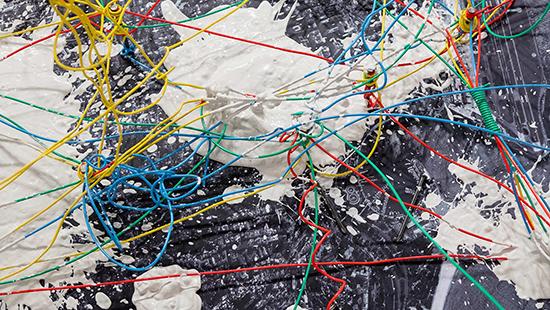
Reperformance of Isozaki Arata’s Incubation Process (1962) at Paço Imperial, Rio de Janeiro, 2016. photo / Jaime Acioli.
Urban Unplanning: The City as Text (ARCH 6408, ROMS 6380, SHUM 6819)
Tuesdays, 12:20–2:15 p.m.
Course Instructor: Pedro Rabelo Erber (associate professor of Luso-Brazilian Studies)
In a 1962 performance titled Incubation Process / Joint Core System, Japanese architect and artist Arata Isozaki invited the public to participate in the allegorical construction of a chaotic, randomly developing city of nails and colorful electric wires on top of a large satellite image of the Tokyo Bay. The piece presented an unequivocal commentary on the massive reconstruction efforts that preceded Tokyo's 1964 Olympics; to the top-down style of urban planning brought forward by the Japanese government, it opposed an organic, unpredictable, and, to some extent, democratic model of urban growth.
At the intersection of literary and urban studies, architecture, art, politics, and economic theory, this seminar approaches the city as an object of competing desires, clashing utopias, and dissenting projects for the future of mankind in its interaction with the natural environment. From the winding alleys of Tokyo to the favelas of Rio de Janeiro and beyond, we will examine representations of the city as backdrop and protagonist, subject and object of a wide range of literary pieces, visual artworks, and theoretical investigations. Particular attention will be given to the city as a privileged site for peripheral fantasies of modernity, as well as to the unexpected, unfinished, disruptive elements that emerge within the planned urban environment. Envisaging the city itself as a text, the seminar will explore multiple possibilities of a hermeneutics of urban space.
In keeping with the interdisciplinary nature of the course, students will be expected to engage with a variety of media, genres, and authors and simultaneously encouraged to bring their diverse disciplinary perspectives and insights to the conversation. We will profit from the vast resources available at the Herbert F. Johnson Museum of Art, at Cornell University Library, as well as from the collection of the Rose Goldsen Archive of New Media Art. Authors, architects, and artists examined range from Walter Benjamin, Michel de Certeau, and Maeda Ai to the Situationists, Akasegawa Genpei, and Kon Wajiro, from Oscar Niemeyer, Lina Bo Bardi, and Max Bill to João do Rio, Hélio Oiticica, Mike Davis, and Teresa Caldeira, among others.